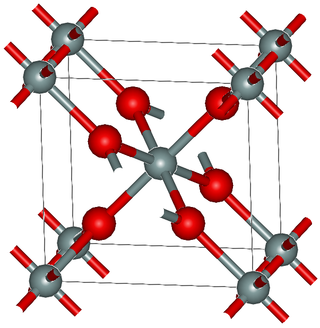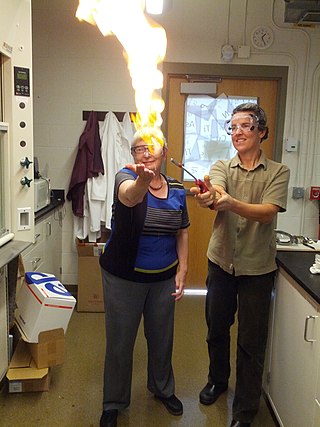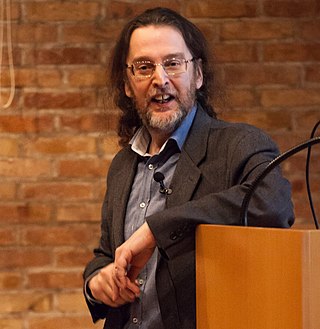Related Research Articles

In geology and mineralogy, a mineral or mineral species is, broadly speaking, a solid substance with a fairly well-defined chemical composition and a specific crystal structure that occurs naturally in pure form.

Carl Friedrich Christian Mohs was a German chemist and mineralogist. He was the creator of the Mohs scale of mineral hardness. Mohs also introduced a classification of the crystal forms in crystal systems independently of Christian Samuel Weiss.

Abraham Gottlob Werner was a German geologist who set out an early theory about the stratification of the Earth's crust and propounded a history of the Earth that came to be known as Neptunism. While most tenets of Neptunism were eventually set aside, Werner is remembered for his demonstration of chronological succession in rocks; for the zeal with which he infused his pupils; and for the impulse he thereby gave to the study of geology. He has been called the "father of German geology".

Coesite is a form (polymorph) of silicon dioxide (SiO2) that is formed when very high pressure (2–3 gigapascals), and moderately high temperature (700 °C, 1,300 °F), are applied to quartz. Coesite was first synthesized by Loring Coes, Jr., a chemist at the Norton Company, in 1953.

Stishovite is an extremely hard, dense tetragonal form (polymorph) of silicon dioxide. It is very rare on the Earth's surface; however, it may be a predominant form of silicon dioxide in the Earth, especially in the lower mantle.
Alfred Edward "Ted" Ringwood FRS FAA was an Australian experimental geophysicist and geochemist, and the 1988 recipient of the Wollaston Medal.

Johann Friedrich August Breithaupt was a German mineralogist and professor at Freiberg Mining Academy in Freiberg, Saxony.
Robert Minard Garrels was an American geochemist. Garrels applied experimental physical chemistry data and techniques to geology and geochemistry problems. The book Solutions, Minerals, and Equilibria co-authored in 1965 by Garrels and Charles L. Christ revolutionized aqueous geochemistry.
Ekhard Karl Hermann Salje, FRS is an Emeritus Professor, and formerly Professor of Mineralogy and Petrology and Head of the Department of Earth Sciences, Cambridge University.

Fritz Henning Emil Paul Berndt Laves was a German crystallographer who served as the president of the German Mineralogical Society from 1956 to 1958. He is the namesake of Laves phases and the Laves tilings; the Laves graph, a highly-symmetrical three-dimensional crystal structure that he studied, was named after him by H. S. M. Coxeter.

Alexandra Navrotsky is a physical chemist in the field of nanogeoscience. She is an elected member of the United States National Academy of Sciences (NAS) and the American Philosophical Society (APS). She was a board member of the Earth Sciences and Resources division of the NAS from 1995 until 2000. In 2005, she was awarded the Urey Medal, by the European Association of Geochemistry. In 2006, she was awarded the Harry H. Hess Medal, by the American Geophysical Union. She is currently the director of NEAT ORU, a primary program in nanogeoscience. She is distinguished professor at University of California, Davis.

Seifertite is a silicate mineral with the formula SiO2 and is one of the densest polymorphs of silica. It has only been found in Martian and lunar meteorites, where it is presumably formed from either tridymite or cristobalite – other polymorphs of quartz – as a result of heating during the atmospheric re-entry and impact to the Earth, at an estimated minimal pressure of 35 GPa. It can also be produced in the laboratory by compressing cristobalite in a diamond anvil cell to pressures above 40 GPa. The mineral is named after Friedrich Seifert (born 1941), the founder of the Bayerisches Geoinstitut at University of Bayreuth, Germany, and is officially recognized by the International Mineralogical Association.
Werner Schreyer (14 November 1930 in Nuremberg; 12 February 2006 in Bochum) was a German mineralogist and experimental metamorphic petrologist. Schreyer completed his undergraduate work in geology and petrology at the University of Erlangen-Nuremberg, obtained his doctorate from the University of Munich in 1957, and in 1966 received his Habilitation from the University of Kiel. He was a professor at Ruhr University Bochum from 1966 to 1996. In 2002 Schreyer became the first German to be awarded the Mineralogical Society of America's highest honor, the Roebling Medal. Schreyer was a leading expert on phase relations in the MgO–Al2O3–SiO2–H2O (MASH) system, specializing in cordierite and minerals with equivalent chemical compositions, and high pressure and ultra high-pressure metamorphic mineral assemblages.

Stephen J. Mackwell is a researcher in geophysics, specializing in laboratory-based studies of the physical, chemical and mechanical properties of geological materials. He is also interested in the transport of fluid components in mantle and crustal rocks on the microscopic and macroscopic scales, and on the effects of such components on mechanical properties. He has authored or co-authored over 80 articles in international scientific journals and is an editor of a book on comparative climatology of terrestrial planets published by the University of Arizona Press.
Hans Peter Eugster was a Swiss-American geochemist, mineralogist, and petrologist.
Dieter Wolke is Professor of Developmental Psychology and Individual Differences at the University of Warwick, Department of Psychology, and at the Division of Health Sciences at Warwick Medical School since 2006. In 2020, he was named by the British Psychological Society for Distinguished Contributions to British Developmental Psychology award. He has also been named as a highly cited researcher, ranking in the top 1% of citations in Web of Science by Clarivate every year since 2018.

Catherine Ann McCammon is a Canadian geoscientist who is employed by the University of Bayreuth. Her research focuses on surface and mantle processes, as well as the physics and chemistry of minerals. She is a Fellow of the European Association of Geochemistry and American Geophysical Union. In 2013, she was awarded the European Geosciences Union Robert Wilhelm Bunsen medal. She is the editor of the journal Physics and Chemistry of Minerals.

Ross John Angel is an internationally recognized researcher in mineralogy, expert in crystallography and elastic properties of geological materials and key industrial materials, which he studies with experimental and analytical approaches. He is the lead author or co-author of over 240 articles in international scientific journals, he received the Dana Medal from the Mineralogical Society of America in 2011 and is currently a director of research at the Institute of Geosciences and Geo-resources of the National Research Council (Italy).
Friedrich Karl Franz Liebau was a German chemist, crystallographer, and mineralogist known for his research in silicates.

Johann Karl Freiesleben was a German mineralogist and mining commissioner in Saxony. He was a childhood friend and correspondent of Alexander von Humboldt and was a promoter of stratigraphy and geognosy as taught by Abraham Gottlob Werner. The mineral Freieslebenite is named in his honour.
References
- 1 2 Küppers, Horst. "Die Geschichte der Mineralogie in Kiel" (PDF). Institut für Geowissenschaften University Kiel. Archived from the original (PDF) on 2011-07-27. Retrieved 2010-05-21.
- 1 2 Abraham-Gottlob-Werner-Medaille Archived 2009-04-14 at the Wayback Machine (in German)
- ↑ "Honorary doctorates - Uppsala University, Sweden". 9 June 2023.
- ↑ The official IMA-CNMNC List of Mineral Names Archived 2011-02-28 at the Wayback Machine , International Mineralogical Association
- ↑ Seifertite: A new natural very dense post-stishovite polymorph of silica, University of Bayreuth
- ↑ Goresy, Ahmed El; Dera, Przemyslaw; Sharp, Thomas G.; Prewitt, Charles T.; Chen, Ming; Dubrovinsky, Leonid; Wopenka, Brigitte; Boctor, Nabil Z.; Hemley, Russell J. (2008). "Seifertite, a dense orthorhombic polymorph of silica from the Martian meteorites Shergotty and Zagami". European Journal of Mineralogy. 20 (4): 523. Bibcode:2008EJMin..20..523G. doi:10.1127/0935-1221/2008/0020-1812. First page preview